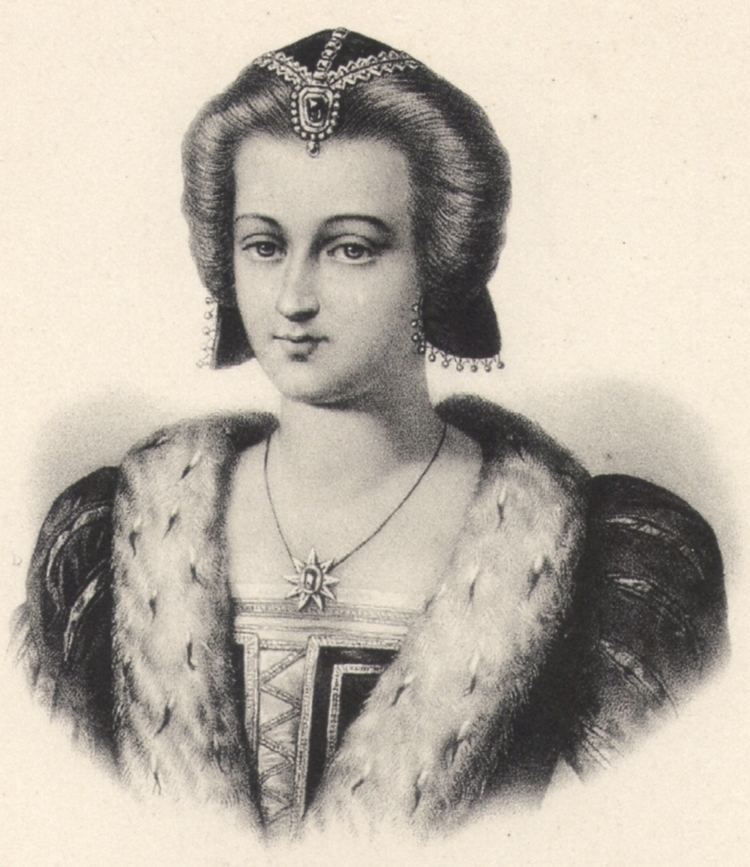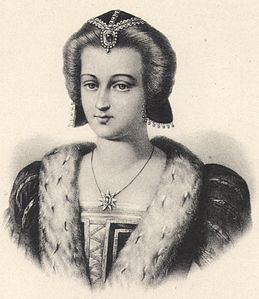Noble family Visconti | Mother Isabelle of Valois Name Valentina Duchess | |
 | ||
Died 4 December 1408(1408-12-04)Blois | ||
Valentina Visconti (1371 – 4 December 1408), was a Sovereign Countess of Vertus, and Duchess consort of Orléans as the wife of Louis de Valois, Duke of Orléans, the younger brother of King Charles VI of France.
Biography

Valentina was born in Milan as the second of the four children of Gian Galeazzo Visconti, the first Duke of Milan, and his first wife Isabelle, a daughter of King John II the Good of France. She was probably named after her paternal great-grandmother Valentina Doria, wife of Stefano Visconti.

After her mother's death in childbirth in 1373, Valentina and her siblings were raised by their paternal grandmother Bianca of Savoy and aunt Violante Visconti. The deaths of her brothers Carlo (1374), Gian Galeazzo (1376) and Azzone (1381) left Valentina as the only surviving child of her parents' marriage and the sovereign Countess of Vertus, a title she shared with her spouse.
In 1380, a marriage was negotiated with her cousin Carlo Visconti, Lord of Parma (fourth son of Bernabò Visconti, Lord of Milan) and a papal dispensation was even granted; however, Bernabò later annulled the betrothal and, in 1382, married his son to a French noblewoman, Beatrice of Armagnac.
The death of Bernabò in 1385 left Gian Galeazzo as the sole ruler over the Visconti inheritance, and with this Valentina's status changed considerably. At this point, the new Lord of Milan opened negotiations with King Wenceslaus of Germany and Bohemia for a marriage between Valentina and his half-brother John of Görlitz; at the same time, he also negotiated a union with Louis II of Anjou, titular King of Naples (who was at that time was betrothed to Lucia Visconti, one of Bernabò's daughters). However, Marie of Blois, Dowager Duchess of Anjou finally cancelled the negotiations, and then Gian Galeazzo turned his attention to his nephew-by-marriage Louis, Duke of Touraine, second son of King Charles V of France and brother of the reigning Charles VI. King Wenceslaus became aware of the double game of Gian Galeazzo, and broke off the negotiations with a letter full of insults, leaving Louis the only suitor of Valentina, his first cousin.
Because of the close relationship between bride and groom, a papal dispensation was granted on 25 November 1386, and the marriage contract was signed on 27 January 1387 in Paris. Valentina received as a dowry the County of Vertus (which was the dowry of her own mother at the time of her marriage in 1348) and the city of Asti, with the sums of 450,000 florins in cash and 75,000 florins in jewelry. In the contract was also stipulated that in absence of male heirs, Valentina would inherit the Visconti dominions. It was because of this, that her grandson Louis XII of France claimed the Duchy of Milan and embarked on the Italian Wars. The marriage by proxy was celebrated three months later, on 8 April, in both the Milanese and French courts.
Valentina was only could leave Milan for France on 23 June 1389, because of "reasons of security" given to her father: in fact, Gian Galeazzo wanted to amend the marriage contract after the pregnancy of his second wife Caterina Visconti (another Bernabò's daughters) ended. Only after the birth of his son Gian Maria on 7 September 1388 did he feel secure enough to send his daughter to France.
Escorted by her paternal cousin Amadeus VII, Count of Savoy and a retinue of 300 knights, Valentina was finally handed to Louis's envoys. The formal marriage took place in the city of Melun, on 17 August 1389.
The union produced eight children:
In 1392 her husband exchanged the Duchy of Touraine for the Duchy of Orléans; since then, Valentina was styled Duchess of Orléans.
Because of intrigues at the court of Charles VI of France and the enmity of the queen, Isabeau of Bavaria-Ingolstadt, Valentina was exiled from the court and had to leave Paris. There were rumours that Isabeau was having an affair with Louis and that Valentina was very close to the King, who was in poor mental health.
A patroness of Eustache Deschamps, who wrote poetry in her honour, she was also the mother of one of France's most famous poets, Charles of Orléans.
Louis de Valois' murder was orchestrated by his cousin and political rival John the Fearless, Duke of Burgundy in 1407. Valentina outlived her husband by only a little over a year, dying at Blois at the age of 40.
